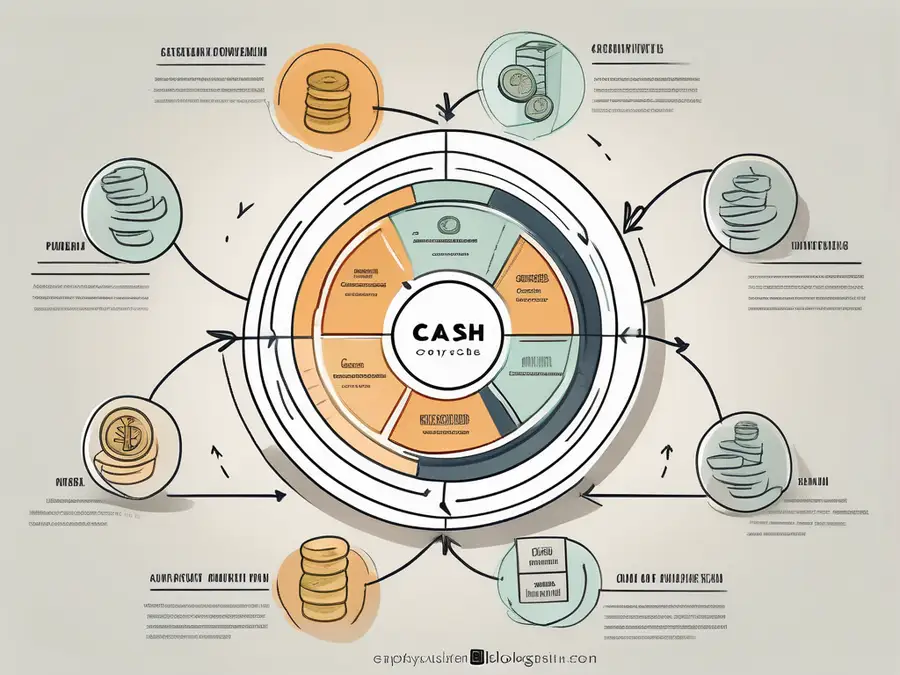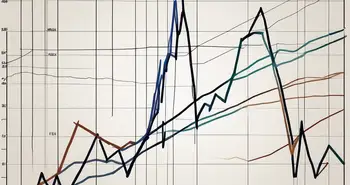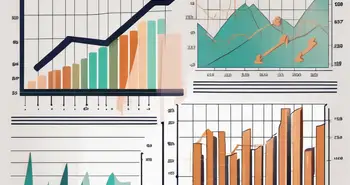What Is a Cash Conversion Cycle?

As a financial expert, I am often asked about the concept of a cash conversion cycle and its impact on business operations. In this comprehensive article, I will provide a detailed explanation of what a cash conversion cycle is, its components, how to calculate it, and its importance in managing cash flow and optimizing business operations. Whether you are a business owner, manager, or simply interested in understanding financial concepts, this article will provide valuable insights into the world of cash conversion cycles.
Understanding the Concept of Cash Conversion Cycle
Before delving into the details, let's start by understanding what a cash conversion cycle actually means. In simple terms, it refers to the time it takes for a company to convert its investments in inventory and other resources into cash inflows. It is a crucial metric for companies to monitor and manage, as it directly affects their cash flow, liquidity, and overall profitability.
Definition of Cash Conversion Cycle
The cash conversion cycle is a comprehensive financial indicator that measures the average time it takes for a company to convert its inventory into cash. It provides insights into how efficiently a company manages its working capital and the ability to generate cash flow from its operational activities. Essentially, the shorter the cash conversion cycle, the better it is for the company's financial health and liquidity.
Importance of Cash Conversion Cycle in Business
The cash conversion cycle plays a crucial role in assessing a company's financial performance and operational efficiency. By understanding and managing this cycle effectively, businesses can optimize their cash flow, improve liquidity, and enhance profitability. It serves as a valuable tool for making informed decisions regarding inventory management, credit policies, and supplier relationships.
Components of the Cash Conversion Cycle
The cash conversion cycle comprises three key components, each representing a different phase of the cycle:
1. Inventory Conversion Period
The inventory conversion period refers to the time it takes for a company to convert its raw materials and finished goods into sales. This period includes the procurement of inventory, production cycles, and finally, the sale of products or services. Efficient inventory management is crucial in reducing this period and ensuring optimal use of resources.
2. Receivables Conversion Period
The receivables conversion period refers to the time it takes for a company to collect payments from its customers after the sale of goods or services. This period can be influenced by the company's credit policy, payment terms, and the efficiency of its collection processes. Timely collections can significantly impact a business's cash flow and liquidity.
3. Payables Deferral Period
The payables deferral period represents the duration between the receipt of goods or services and the payment made by the company to its suppliers. By deferring payments within permissible terms, businesses can utilize their cash reserves more effectively and improve their cash conversion cycle.
Calculating the Cash Conversion Cycle
Now that we understand the components of the cash conversion cycle, let's explore how to calculate it. Although there are various formulas available, the most commonly used method is as follows:
Step-by-Step Guide to Calculation
- Calculate the average inventory for a specific period by taking the sum of the opening and closing inventory and dividing it by two.
- Next, calculate the Inventory Turnover Ratio by dividing the cost of goods sold (COGS) by the average inventory.
- Determine the average accounts receivable by adding the opening and closing balances and dividing by two.
- Calculate the Receivables Turnover Ratio by dividing net credit sales by the average accounts receivable.
- Finally, compute the Cash Conversion Cycle by adding the Inventory Conversion Period and the Receivables Conversion Period, and subtracting the Payables Deferral Period.
Interpreting the Results
The result of the cash conversion cycle calculation provides valuable insights into a company's financial health and efficiency. A shorter cash conversion cycle indicates a more efficient use of working capital and faster conversion of resources into cash. On the other hand, a longer cycle may signal operational inefficiencies, higher financing costs, and potential cash flow challenges.
Impact of Cash Conversion Cycle on Business Operations
Now that we have a clear understanding of the cash conversion cycle and how to calculate it, let's explore its impact on business operations:
Cash Flow Management
The cash conversion cycle is a vital tool in managing a company's cash flow effectively. By reducing the cycle duration, businesses can free up cash reserves, thereby improving their ability to meet financial obligations, invest in growth opportunities, and withstand market uncertainties.
Business Liquidity
A shorter cash conversion cycle improves a company's liquidity position as it allows for faster access to cash. This ensures that the business has sufficient funds to pay suppliers promptly, cover operational expenses, and seize strategic opportunities for expansion or diversification.
Profitability and Growth
An optimized cash conversion cycle positively impacts a company's profitability. By minimizing the time it takes to convert investments into cash, businesses can enhance their return on investment, reduce financing costs, and reinvest in the growth and development of their core operations.
Strategies to Optimize the Cash Conversion Cycle
Now that we have explored the significance of the cash conversion cycle, let's discuss strategies to optimize it:
Inventory Management Techniques
Implementing efficient inventory management techniques is crucial for minimizing the inventory conversion period. This can include adopting just-in-time (JIT) inventory systems, implementing demand forecasting tools, and regularly monitoring inventory turnover ratios.
Accounts Receivable Strategies
To reduce the receivables conversion period, businesses can implement effective credit policies, establish clear payment terms, and actively pursue timely collections. Streamlining billing processes, offering prompt incentives for early payments, and leveraging technology for automated payment reminders can also significantly enhance receivables management.
Accounts Payable Tactics
By negotiating favorable payment terms with suppliers, businesses can extend their payables deferral period without negatively impacting relationships. However, it's important to strike a balance between cash flow optimization and maintaining good rapport with suppliers.
As an expert in financial management, I have witnessed the profound impact that an optimized cash conversion cycle can have on a company's success. By employing strategies tailored to their specific needs and industry dynamics, businesses can unlock significant potential for growth, profitability, and financial stability.
If you found this article informative and would like to learn more about the cash conversion cycle or financial management in general, feel free to reach out with any questions. I'm here to help you navigate the complex world of cash flow management and make informed decisions that will drive your business towards long-term success.
Frequently Asked Questions (FAQ)
What is a cash conversion cycle?
A cash conversion cycle is a financial metric that represents the time it takes for a company to convert its investments in inventory and other resources into cash inflows. It measures the efficiency of a company's working capital management and provides insights into its cash flow, liquidity, and profitability.
How is the cash conversion cycle calculated?
The cash conversion cycle is calculated by adding the Inventory Conversion Period (time to convert inventory into sales) and the Receivables Conversion Period (time to collect payments from customers), and subtracting the Payables Deferral Period (time to make payments to suppliers).
Why is the cash conversion cycle important?
The cash conversion cycle is important because it helps businesses assess their operational efficiency, manage cash flow effectively, improve liquidity, and enhance profitability. By reducing the cycle duration, companies can utilize their working capital more efficiently and generate cash flow from operational activities.
How can a company optimize its cash conversion cycle?
There are several strategies that companies can employ to optimize their cash conversion cycle. These include implementing efficient inventory management techniques, adopting effective accounts receivable strategies, and negotiating favorable payment terms with suppliers. By focusing on these areas, businesses can reduce the cycle duration and improve their cash flow, liquidity, and profitability.
Can a shorter cash conversion cycle lead to better financial performance?
Yes, a shorter cash conversion cycle is generally associated with better financial performance. It indicates that a company is efficient in converting its investments into cash, managing working capital, and generating cash flow. This can lead to improved liquidity, reduced financing costs, and greater opportunities for growth and profitability.
Remember, understanding and managing the cash conversion cycle is crucial for any business. By optimizing this cycle, you can improve your cash flow, enhance your financial health, and position your company for long-term success. Implement these strategies and watch your business thrive!
Ready to take control of your financial performance and optimize your cash conversion cycle? Discover Morpher, the revolutionary trading platform that empowers you with zero fees, infinite liquidity, and the flexibility to trade across multiple asset classes. Whether you're interested in stocks, cryptocurrencies, or even niche markets like NFTs, Morpher's blockchain-based platform provides a unique trading experience tailored to your needs. With fractional investing, short selling capabilities, and up to 10x leverage, Morpher is designed to help you maximize your investment potential while ensuring safety and control. Sign Up and Get Your Free Sign Up Bonus today to transform the way you invest with Morpher.

Disclaimer: All investments involve risk, and the past performance of a security, industry, sector, market, financial product, trading strategy, or individual’s trading does not guarantee future results or returns. Investors are fully responsible for any investment decisions they make. Such decisions should be based solely on an evaluation of their financial circumstances, investment objectives, risk tolerance, and liquidity needs. This post does not constitute investment advice.

Painless trading for everyone
Hundreds of markets all in one place - Apple, Bitcoin, Gold, Watches, NFTs, Sneakers and so much more.

Painless trading for everyone
Hundreds of markets all in one place - Apple, Bitcoin, Gold, Watches, NFTs, Sneakers and so much more.









